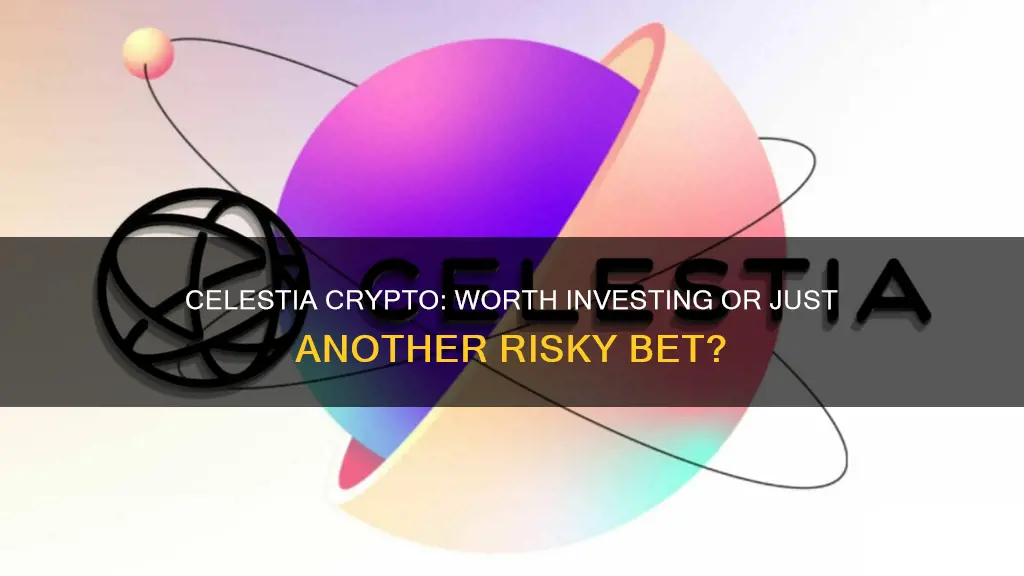
Celestia (TIA) is a Layer 1 blockchain that aims to make it easy for anyone to launch their own blockchain. Its unique selling point is its 'modular' approach, which promises a more adaptable, scalable, and cost-effective deployment of blockchains and decentralized apps. The Celestia blockchain mainnet and its TIA token were launched in late 2023, and the network quickly gained a high profile among investors. In this article, we will explore whether Celestia crypto is a good investment.
What You'll Learn

Celestia's unique 'modular' approach
Celestia's Unique Modular Approach
The world of blockchain is evolving, and modular blockchains are at the forefront of this revolution. Leading the charge is Celestia, a pioneer in addressing the challenges of scalability and accessibility with its unique modular architecture. As the first modular blockchain network, Celestia introduces a novel approach that separates consensus and data availability from execution, paving the way for a more efficient and secure future for blockchain technology.
At its core, Celestia is a modular data availability network designed to facilitate the deployment of scalable and secure blockchains. Unlike traditional monolithic blockchains, where all functions are integrated into a single layer, Celestia takes a different path. It decouples the consensus and data availability layers from the execution layer, allowing developers to create highly customizable and efficient blockchain applications.
The beauty of Celestia's modular design lies in its ability to enable different blockchain components to operate independently yet cohesively. This separation of functions offers greater flexibility, empowering developers to deploy custom execution environments while relying on Celestia for data availability and consensus. This unique division of tasks is what sets Celestia apart and makes it a true innovator in the blockchain space.
One of the key advantages of Celestia's modular approach is its scalability. By separating data availability from execution, Celestia can handle a larger volume of transactions and data, making it an ideal solution for supporting complex decentralized applications (dApps) and enabling the mass adoption of blockchain technology. This scalability is further enhanced by Celestia's innovative Data Availability Sampling (DAS) method, which allows light nodes to verify data availability without downloading the entire dataset.
Another benefit of Celestia's modularity is its security. The use of DAS ensures that data remains available and verifiable, even as the network scales. This security measure is vital for maintaining the integrity and trustworthiness of blockchain applications, providing users with peace of mind. Additionally, Celestia's modular design allows for better interoperability, facilitating secure cross-chain interactions and seamless data sharing between different blockchains.
The flexibility offered by Celestia's modular architecture is also noteworthy. With Celestia, developers have complete freedom in the execution environment, enabling them to build diverse use cases and customize blockchain solutions to meet specific needs. This level of customization is a significant advantage over the one-size-fits-all approach of monolithic blockchains.
In conclusion, Celestia's unique modular approach revolutionizes the blockchain industry. By separating consensus, data availability, and execution layers, Celestia offers enhanced scalability, security, and flexibility. Its modular design empowers developers to build specialized blockchain applications, collaborate effectively, and drive the next wave of innovation in the blockchain space. With its forward-thinking solutions, Celestia is creating a more robust, user-centric, and adaptable blockchain ecosystem for all.
Diversifying Your Portfolio: Investing in Multiple Cryptocurrencies
You may want to see also

Celestia's TIA token
Celestia is a Layer 1 blockchain designed to facilitate the seamless rollout of supplementary networks, while ensuring scalability, decentralisation, and security. It is the first modular blockchain network that makes it easy for anyone to securely deploy their own blockchain with minimal overhead.
The Celestia blockchain serves as a foundational platform for the creation of other EVM-compatible networks, streamlining the process to be both cost-efficient and user-friendly. It is built upon the Tendermint consensus algorithm and operates as part of the Cosmos ecosystem.
The Celestia blockchain's native token, TIA, has a market capitalisation of over $US1.3 billion, placing it in the top 100 coins globally. TIA started the year at around $US12, reached an all-time high of over $US20 in February, and is currently worth $US6.90.
The TIA token has three main functions within the Celestia blockchain:
- Developers use TIA to pay gas fees on transactions and to publish data on the network's data availability layer.
- Network validators and delegators stake TIA to support network consensus activities, such as verifying and securing transactions. They also earn staking rewards in the form of TIA.
- TIA holders have some governance powers, being able to propose and vote on proposals to change a subset of network parameters.
The TIA token is currently available on several centralised exchanges, including WhiteBIT, Binance, KuCoin, Gate, BingX, Mexc, OKX, and Bybit.
Loopring Coin: A Smart Investment Decision?
You may want to see also

Celestia's market performance
The Celestia blockchain mainnet and its TIA token were launched in late 2023, and the network quickly gained a high profile among investors due to its unique value proposition. Celestia is a Layer 1 blockchain designed to be 'modular' in nature, making it easy for developers to launch their own blockchain. This has resulted in a high level of interest and investment in the project.
At the time of writing (June 2024), the TIA token is trading at $6.90 USD, according to Forbes Advisor Australia. This is a significant increase from its initial listing price of $2.08, but the token's value seems to be trending downwards. TIA started 2024 at around $12 and reached an all-time high of over $20 in February. The current live price of TIA is $5.45, according to CoinMarketCap, with a 24-hour trading volume of $146,785,991 USD. The circulating supply of TIA tokens is 193 million, with a maximum supply of 1 billion.
Celestia's TIA token has a market capitalisation of over $1.3 billion, placing it in the top 100 coins globally. The project has attracted considerable venture capital investment, including a $1.5 million seed round in 2021 and $55 million raised in 2022. The investment statistics for Celestia, according to Crunchbase, show that Celestia Labs has raised an aggregate of $56.5 million from 38 distinct investors, including notable names like Polychain, OKX Ventures, Binance Labs, and Bain Capital Crypto.
The TIA token launch was wildly successful, but it's unclear how much of the hype is warranted and what the real appetite for this modular technology is. The volatility of the crypto markets makes it challenging to predict how an investment in TIA will perform in the future. However, the reducing level of expertise required to deploy a blockchain and build applications is a positive sign for Celestia's market performance.
The Legality of Cryptocurrency Investments: What You Need to Know
You may want to see also

Celestia's blockchain scalability
Celestia is a modular data availability (DA) network that enables anyone to securely launch their own blockchain. It is the first modular blockchain network, providing a decentralised data availability layer to support the broader blockchain ecosystem.
The core of Celestia's blockchain scalability lies in its modular approach. Historically, blockchains like Bitcoin and Ethereum have operated as monolithic chains, handling consensus, execution, data availability, and settlement all on the base layer. This limits scalability due to the heavy bandwidth demands of replicating bulky data across all nodes.
Celestia addresses this challenge by modularising these core functions through its data availability layer:
- Consensus Layer— Celestia's consensus relies on a minimal Proof-of-Stake mechanism for data ordering and availability guarantees.
- Data Availability Layer— Celestia nodes sample and store data committed by rollups and execution layers. Light clients, or users, can verify data availability through fraud proofs without needing to download all the data. This is achieved through Data Availability Sampling (DAS), which enables light clients to verify that all transaction data has been published and is available.
- Execution Layer— Developers can deploy custom execution environments (rollups, sidechains, sovereign chains) that post transaction data to Celestia and verify it through light clients.
- Settlement— Modular blockchains rely on bridges and cross-chain communication protocols to transfer assets across execution layers.
By separating these layers, each can specialise and work together seamlessly. This allows rollups and dApps to scale to thousands of transactions per second without sacrificing decentralisation.
The successful implementation of DAS is a key milestone in Celestia's mission to provide a secure and scalable data availability layer for the blockchain ecosystem. DAS enables Celestia to scale with the number of users, ensuring that as the light node network grows, it can scale to the data throughput needed for millions of rollups without compromising security.
The Best Cryptocurrency to Invest in Today
You may want to see also

Celestia's data availability sampling
Celestia is a modular data availability (DA) network that allows anyone to launch their own blockchain. It is the first modular blockchain network that makes it easy for anyone to securely deploy their own blockchain with minimal overhead.
DAS allows Celestia to scale with the number of users (light nodes). As the light node network grows, Celestia can scale to the data throughput needed for millions of rollups without compromising security for end users. This dynamic throughput that scales with the number of users is called data availability.
Data availability answers the question: has the data for this blockchain been published? It is critical to the security of any blockchain because it ensures that anyone can inspect the ledger of transactions and verify it. Users of monolithic blockchains usually download all the data to check its availability. However, as blocks get bigger, it becomes impractical for normal users to download all the data, and they cannot verify the chain. Modular chains solve this problem by allowing users to verify very large blocks using data availability sampling.
With Celestia, deploying a customizable blockchain becomes as easy as deploying a smart contract.
Little Money, Big Risk: Is Bitcoin Worth the Gamble?
You may want to see also
Frequently asked questions
Celestia is a modular data availability (DA) network that makes it easy for anyone to securely launch their own blockchain. It is the first modular blockchain network.
Celestia is a Layer 1 blockchain, designed to be 'modular' in nature with the goal of making it easy for developers to launch their own blockchain. It does this by enabling developers to combine existing rollup (aka Layer 2 scaling solution) technology options to create their own customised stack.
The TIA token is the native token of the Celestia blockchain. It has a market capitalisation of over $US1.3 billion, placing it in the top 100 coins globally.
TIA started the year at around $US12, reached an all-time high of over $US20 in February, and is currently worth $US6.90. This is still up over 200% on its initial listing price of $US2.08 around 240 days prior.
It is hard to say. Crypto markets are volatile, with regular significant swings based purely on sentiment. Celestia's TIA token launch was wildly successful, but it is unclear how much of the hype is warranted and what the real appetite for this modular technology is. There are also additional risks to TIA’s value, including future substantial token unlocks that could increase sell-side pressure.







